seats CHEVROLET ASTRO PASSENGER 1993 1.G User Guide
[x] Cancel search | Manufacturer: CHEVROLET, Model Year: 1993, Model line: ASTRO PASSENGER, Model: CHEVROLET ASTRO PASSENGER 1993 1.GPages: 345, PDF Size: 19 MB
Page 28 of 345
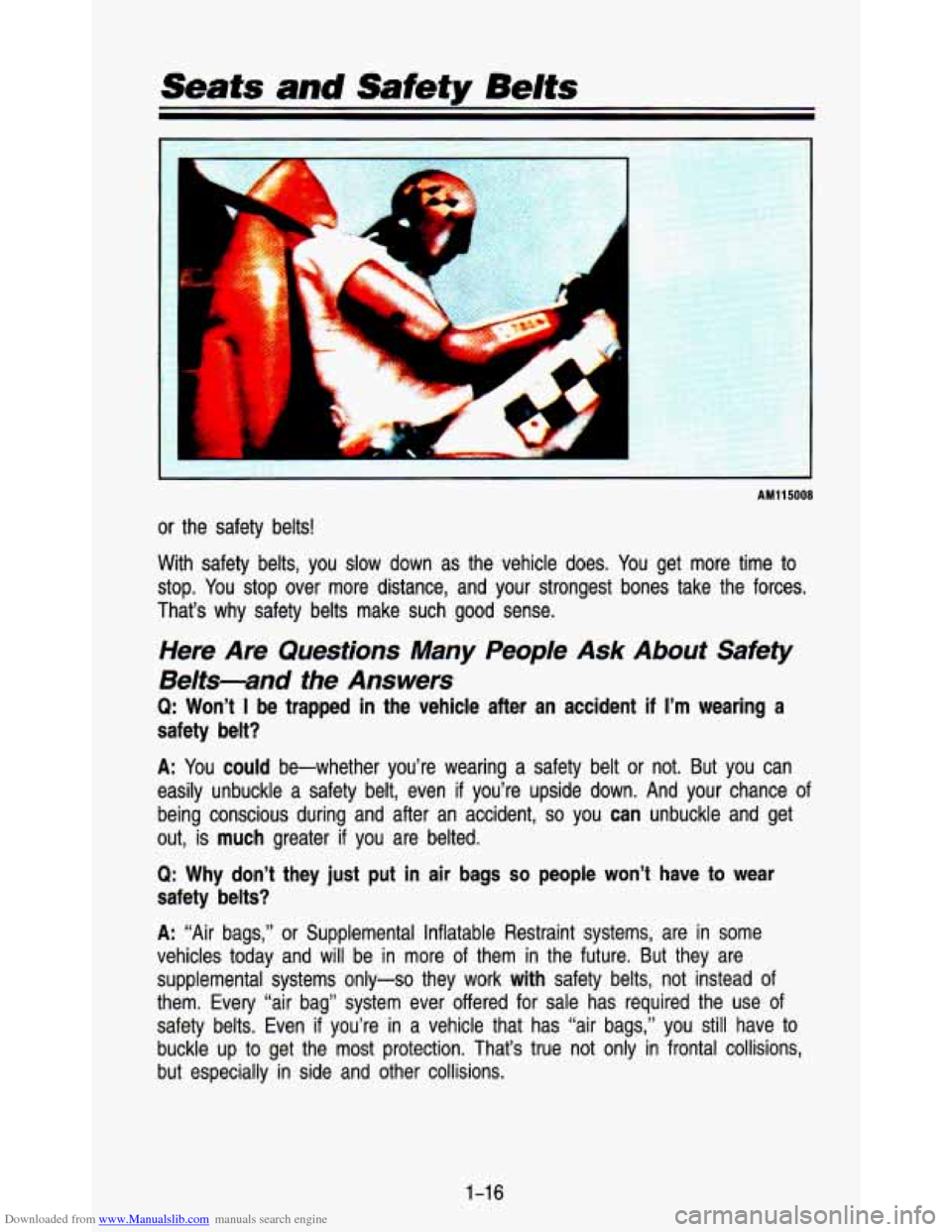
Downloaded from www.Manualslib.com manuals search engine Seats and Safety Belts
AM115008
or the safety belts!
With safety belts, you slow down as the vehicle does. You get more time to
stop. You stop over more distance, and your strongest bones take the\
forces.
That’s why safety belts make such good sense.
Here Are Questions Many People Ask About Safety
Belts-and the Answers
Q: Won’t I be trapped in the vehicle after an accident if I’m wearing a
safety belt?
A: You could be-whether you’re wearing a safety belt or not. But you can
easily unbuckle a safety belt, even
if you’re upside down. And your chance of
being conscious during and after an accident,
so you can unbuckle and get
out, is
much greater if you are belted.
Q: Why don’t they just put in air bags so people won’t have to wear
safety belts?
A: “Air bags,” or Supplemental Inflatable Restraint systems, are in some
vehicles today and will be in more of them in the future. But they are
supplemental systems only-so they work
with safety belts, not instead of
them. Every “air bag” system ever offered for sale has r\
equired the use of
safety belts. Even
if you’re in a vehicle that has “air bags,’’ you still have to
buckle up to get the most protection. That’s true not only in frontal collisions,
but especially in side and other collisions.
1-16
Page 30 of 345
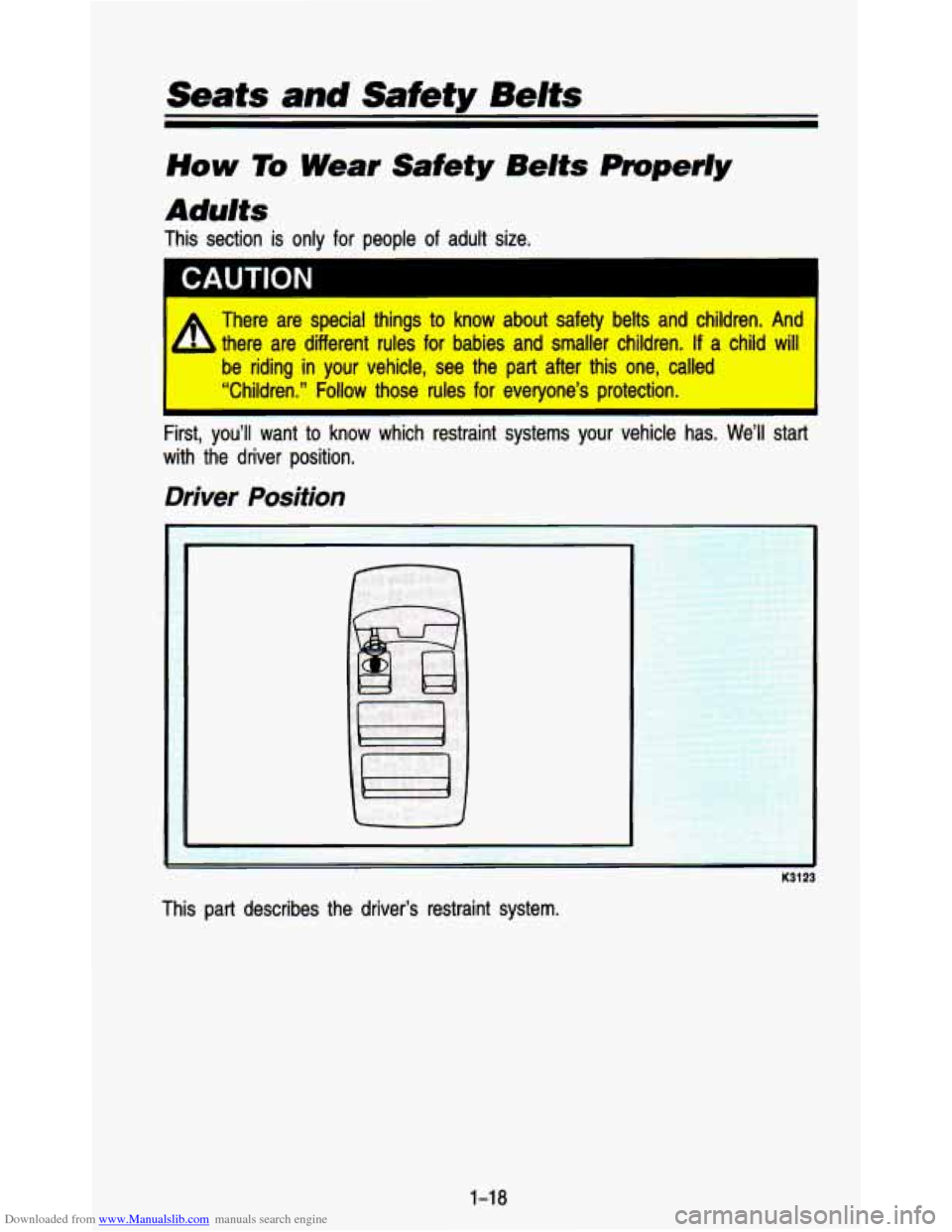
Downloaded from www.Manualslib.com manuals search engine Seats and Safety Belts
How To Wear Safety Belts Prroperiy
Adults
This section is only for people of adult size.
I CAUTION
There are special things to know about safety belts and childr\
en. And
there are different rules for babies and smaller children.
If a child will
“Children.” Follow those rules for everyone’s protection.\
I be riding in your vehicle, see the part after this one, called
st, you’ll want to know which restraint systems your vehicle has. We’ll start
with the driver position.
Driver Position
U
This part describes the driver’s restraint system.
1-1 8
Page 31 of 345
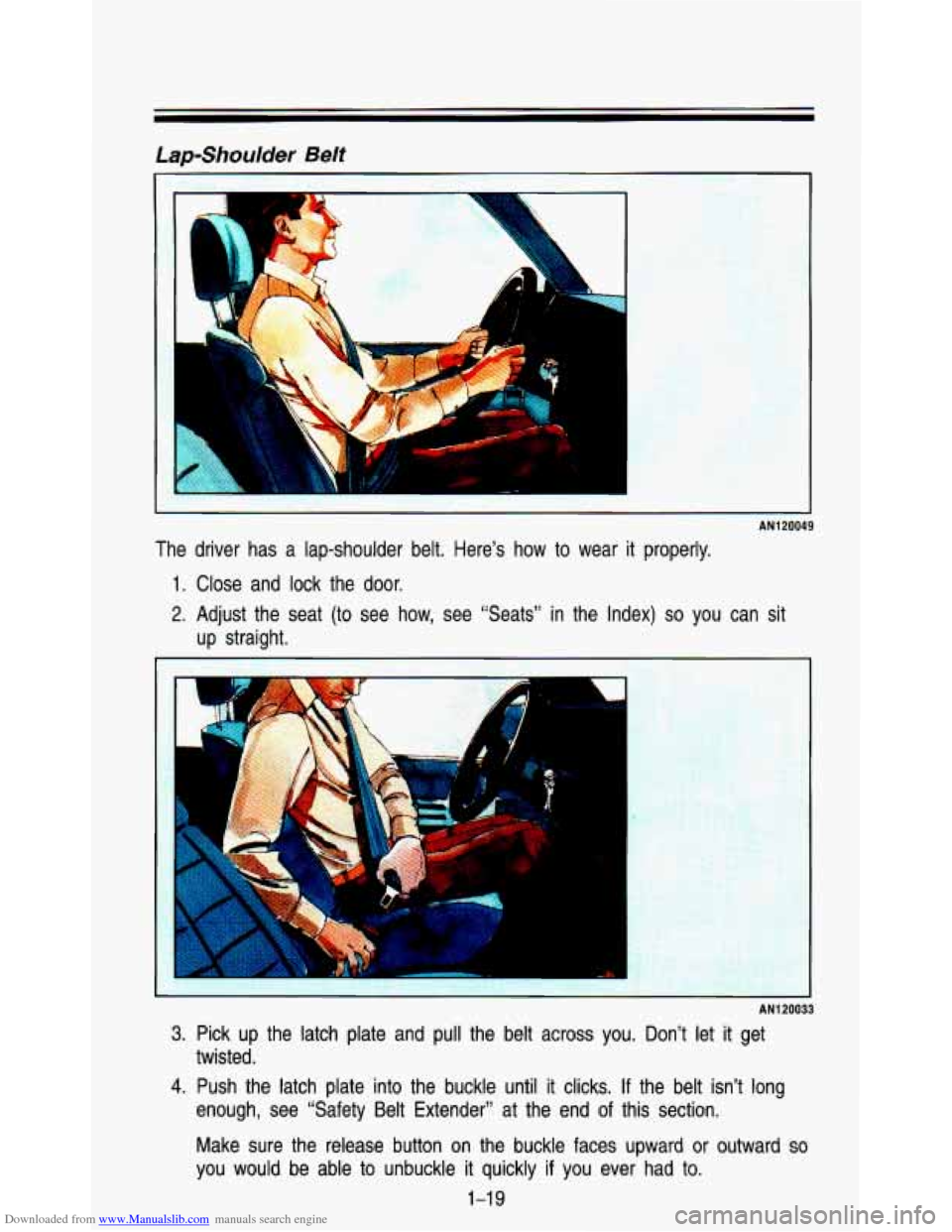
Downloaded from www.Manualslib.com manuals search engine Lap-Shoulder Belt I
AN1 20049
The driver has a lap-shoulder belt. Here’s how to wear it properly.
1. Close and lock the door.
2. Adjust the seat (to see how, see “Seats” in the Index) so you can sit
up straight.
. .. .
AN120033
3. Pick up the latch plate and pull the belt across you. Don’t let it get
4. Push the latch plate into the buckle until it clicks. If the belt isn’t long
twisted.
enough, see “Safety Belt Extender” at the end
of this section.
Make sure the release button on the buckle faces upward
or outward so
you would be able to unbuckle it quickly if you ever had to.
1-1 9
Page 32 of 345
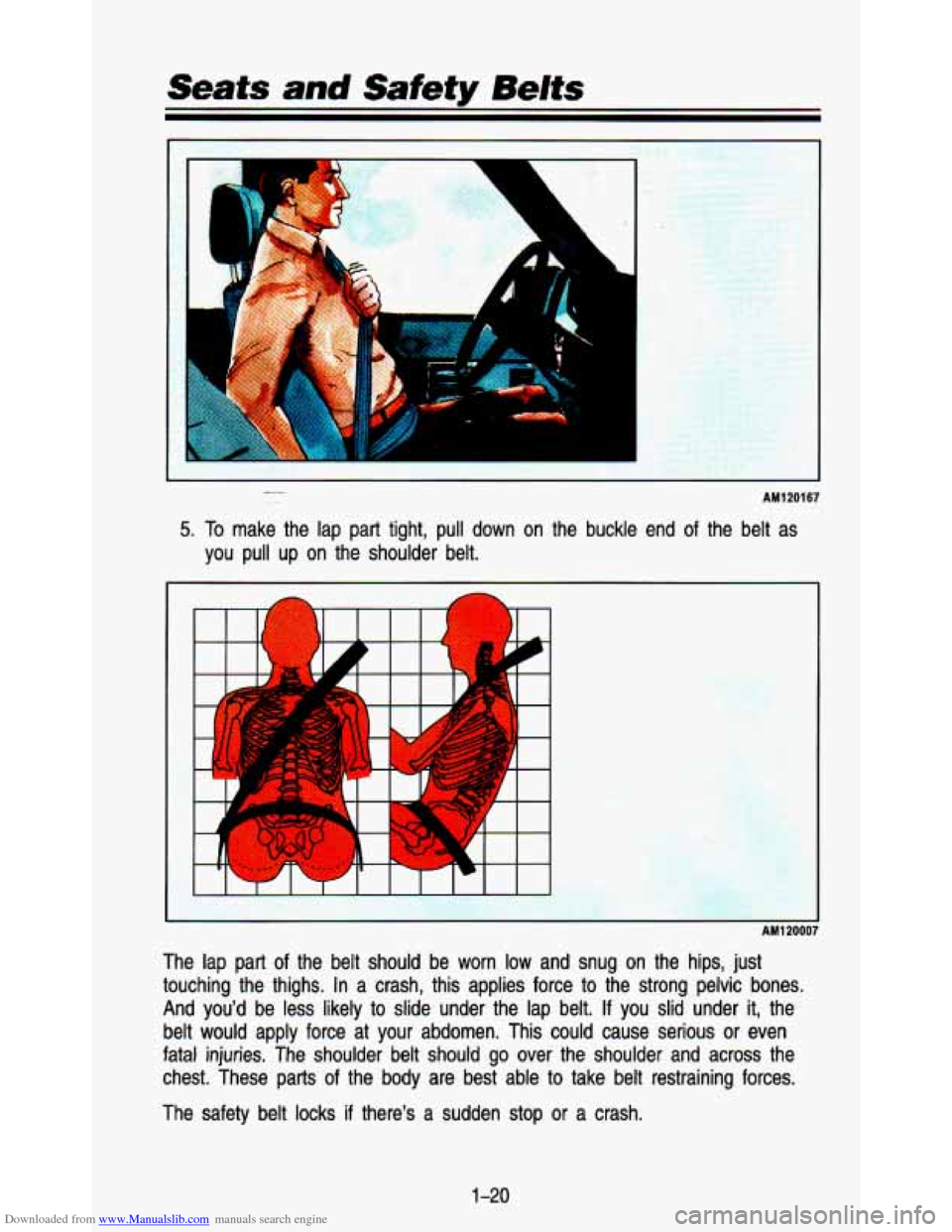
Downloaded from www.Manualslib.com manuals search engine Seats and Safety Belts
L
AM120167
5. To make the lap part tight, pull down on the buckle end of the \
belt as
you pull up on the shoulder belt.
d
The lap part of the belt should be worn low and snug on the hips, just
touching the thighs. In a crash, this applies force to the strong pelvic bones.
And you'd be less likely to slide under the lap belt.
If you slid under it, the
belt would apply force at your abdomen. This could cause serio\
us or even
fatal injuries. The shoulder belt should go over the shoulder and ac\
ross the
chest. These parts of the body are best able
to take belt restraining forces.
The safety belt locks
if there's a sudden stop or a crash.
1-20
Page 34 of 345
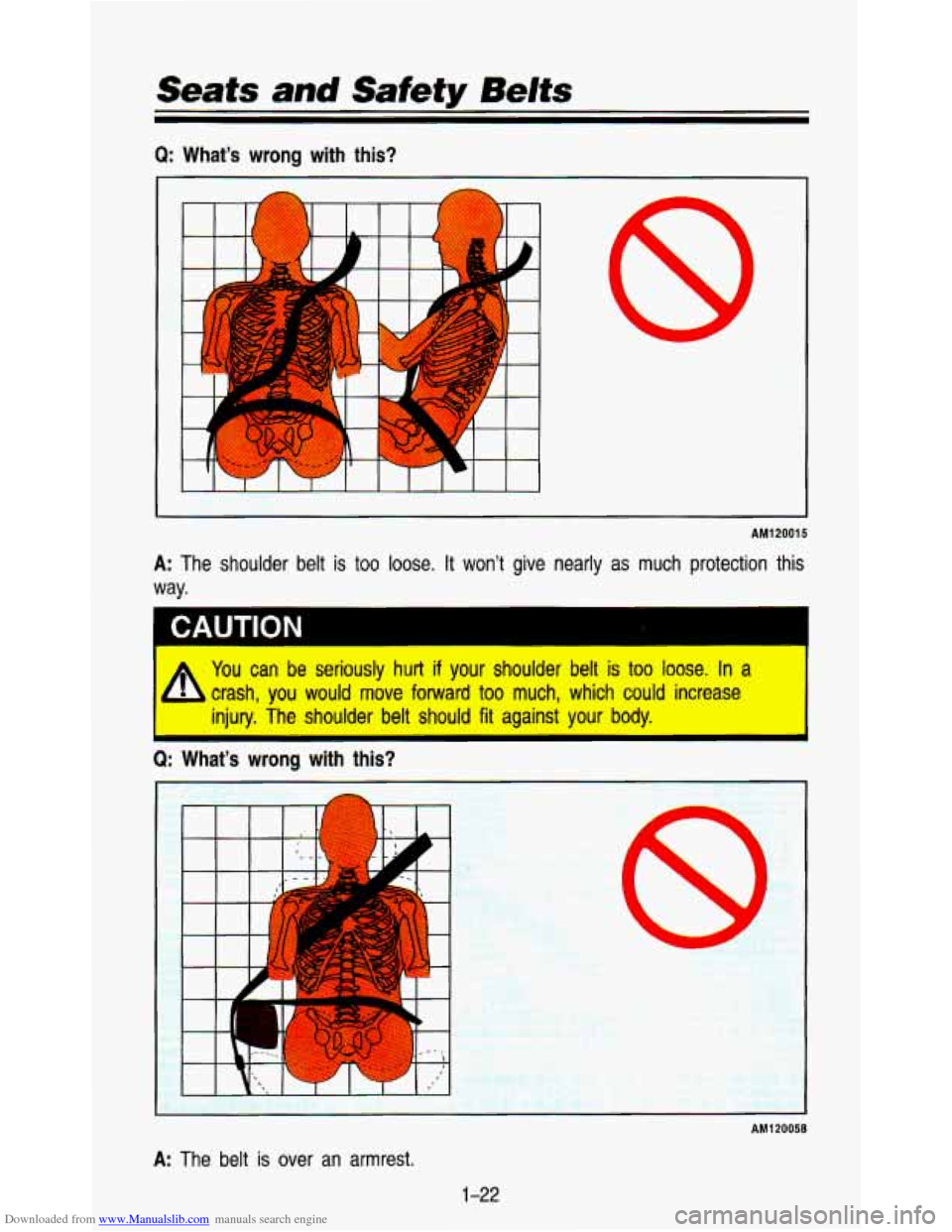
Downloaded from www.Manualslib.com manuals search engine Seats and Safety Belts
Q: What’s wrong with this?
P
I I -7
I
8
AM120015
A: The shoulder belt is too loose. It won’t give nearly as much protection this
way.
You can be seriously hurt if your shoulder belt is too loose. In a
crash, you would move forward too much, which could increase
injury.
The shoulder belt should fit aqainst your body.
AM120058
A: The belt is over an armrest.
1-22
Page 36 of 345
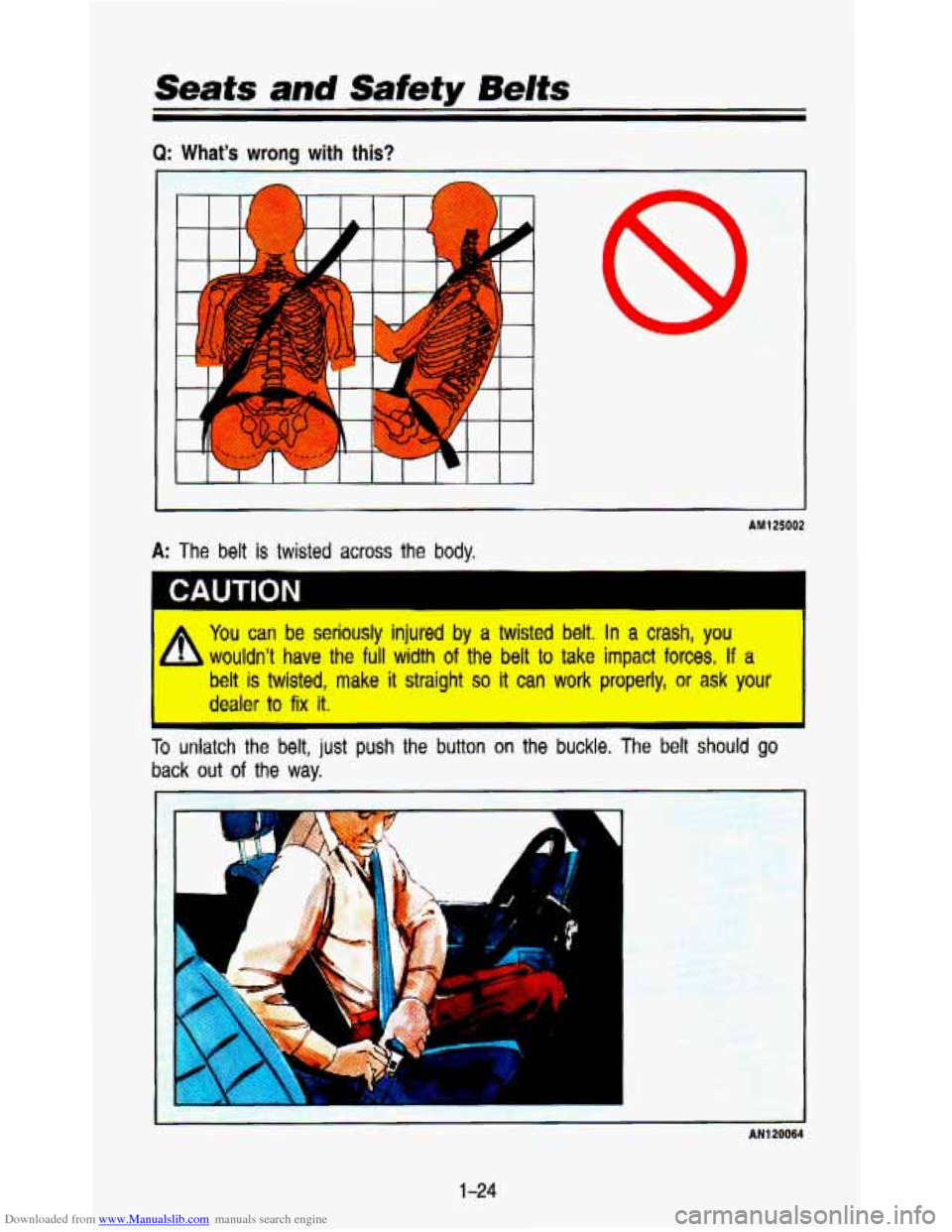
Downloaded from www.Manualslib.com manuals search engine Seats and Safety Belts
Q: What's wrong with this?
i
i
II
AM125002
I CAUTION
* You can be seriously injured by a twisted belt. In a crash, you
-- wouldn't have the full width of the belt to take impact forces. If a
I dealer to fix it. I
belt is twisted, make it straight so it can work properly, or ask your
Ib unlatch the belt, just push the button on the buckle. The belt should go
back out of the way.
m
--iu
1 -24
Page 38 of 345
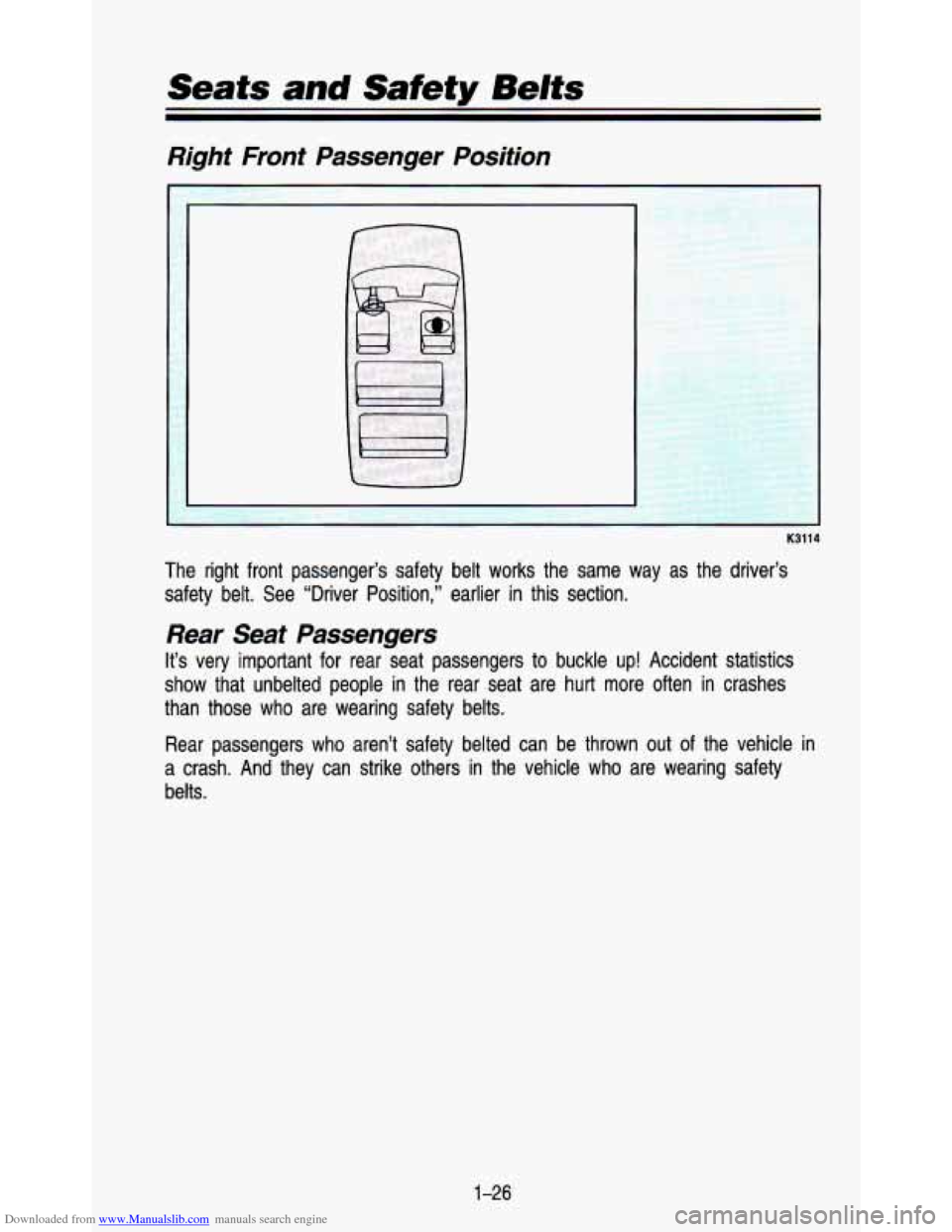
Downloaded from www.Manualslib.com manuals search engine Seats and Safety Belts
Right Front Passenger Position
K3114
The right front passenger’s safety belt works the same way as the driver’s
safety belt. See “Driver Position,” earlier in this sectio\
n.
Rear Seat Passengers
It’s very important for rear seat passengers to buckle up! \
Accident statistics
show that unbelted people in the rear seat are hurt more ofte\
n in crashes
than those
who are wearing safety belts.
Rear passengers who aren’t safety belted can be thrown out of the vehicle in
a crash. And they can strike others in the vehicle who are wear\
ing safety
belts.
1-26
Page 40 of 345
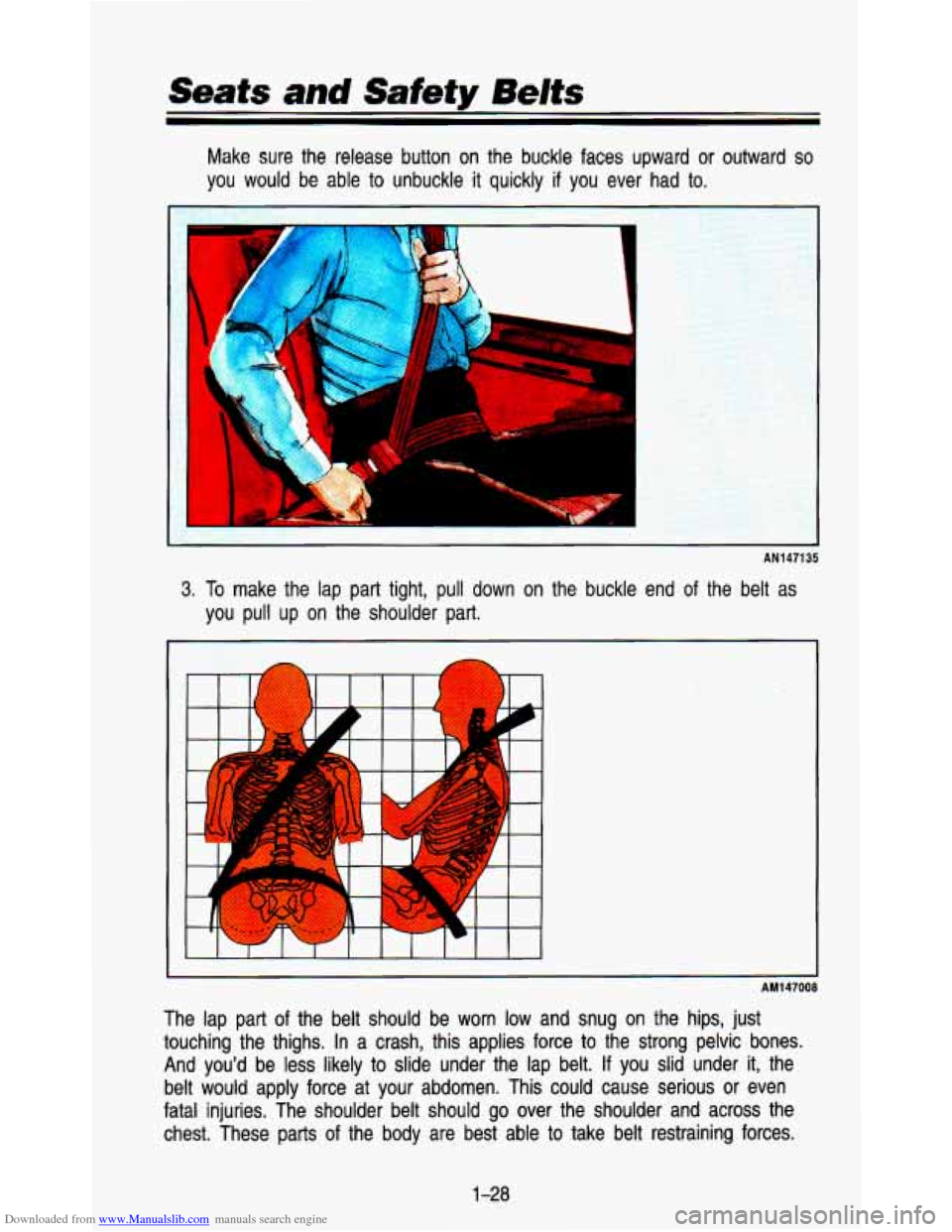
Downloaded from www.Manualslib.com manuals search engine Seats and Safety Belts
Make sure the release button on the buckle faces upward or outward so
you would be able to unbuckle it quickly if you ever had to.
AN147135
3. To make the lap part tight, pull down on the buckle end of the belt as
you pull up on the shoulder part.
I AM14700'
The lap part of the belt should be worn low and snug on the\
hips, just
touching the thighs. In a crash, this applies force to the strong pelvic bones.
And you'd be less likely to slide under the lap belt.
If you slid under it, the
belt would apply force at your abdomen. This could cause serio\
us or even
fatal injuries. The shoulder belt should go over the shoulder and ac\
ross the
chest. These parts
of the body are best able to take belt restraining forces.
1-28
Page 42 of 345
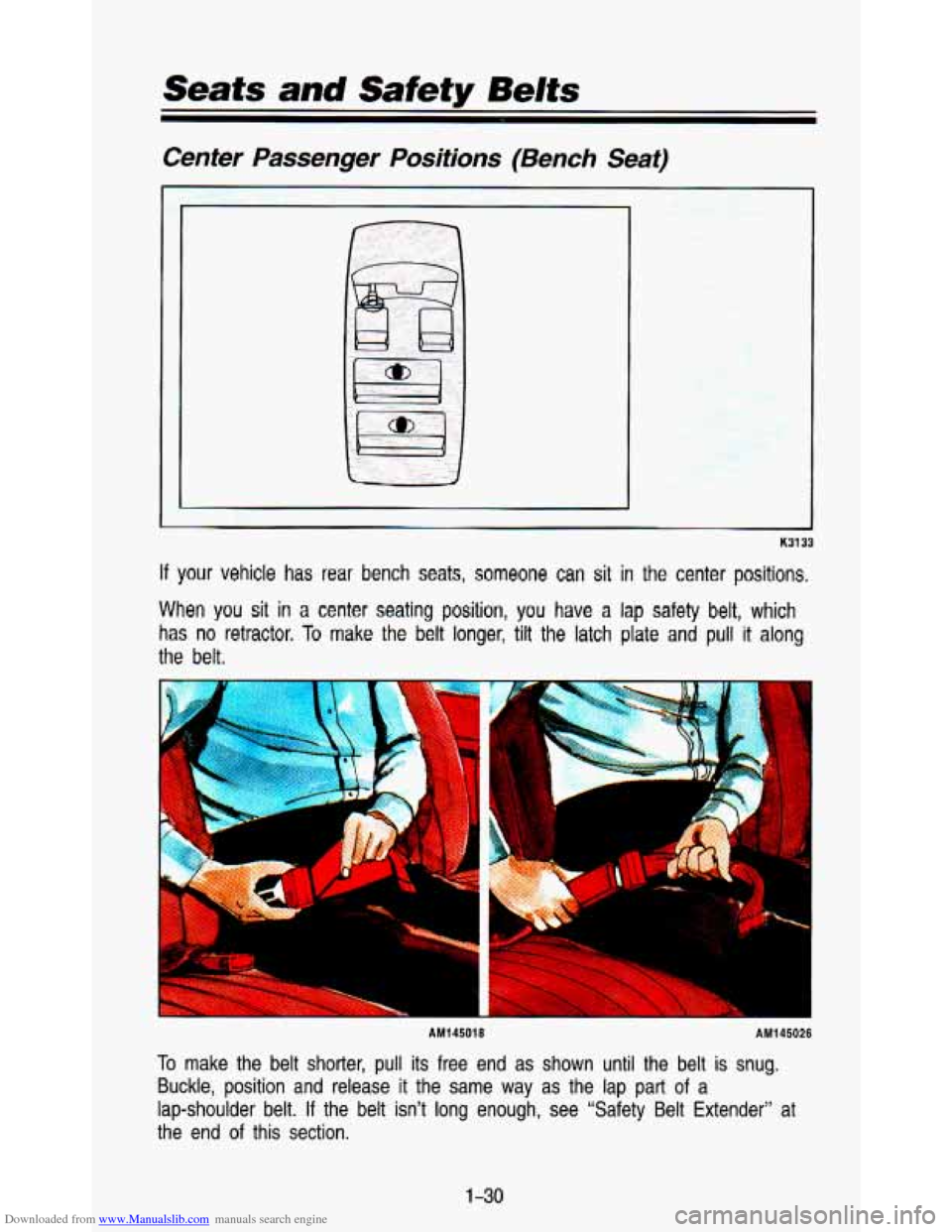
Downloaded from www.Manualslib.com manuals search engine Center Passenger Positions (Bench Seat)
If your vehicle has rear bench seats, someone can sit in the center positions.
When you sit in a center seating position, you have a lap safety belt, which
has no
retractor. To make the belt longer, tilt the latch plate and pull it along
tho belt.
I
AM145018 AM145026
To make the belt shorter, pull its free end as shown until the belt is snug.
Buckle, position and release
it the same way as the lap part of a
lap-shoulder belt.
If the belt isn’t long enough, see “Safety Belt Extender” \
at
the end of this section.
1-30
Page 44 of 345
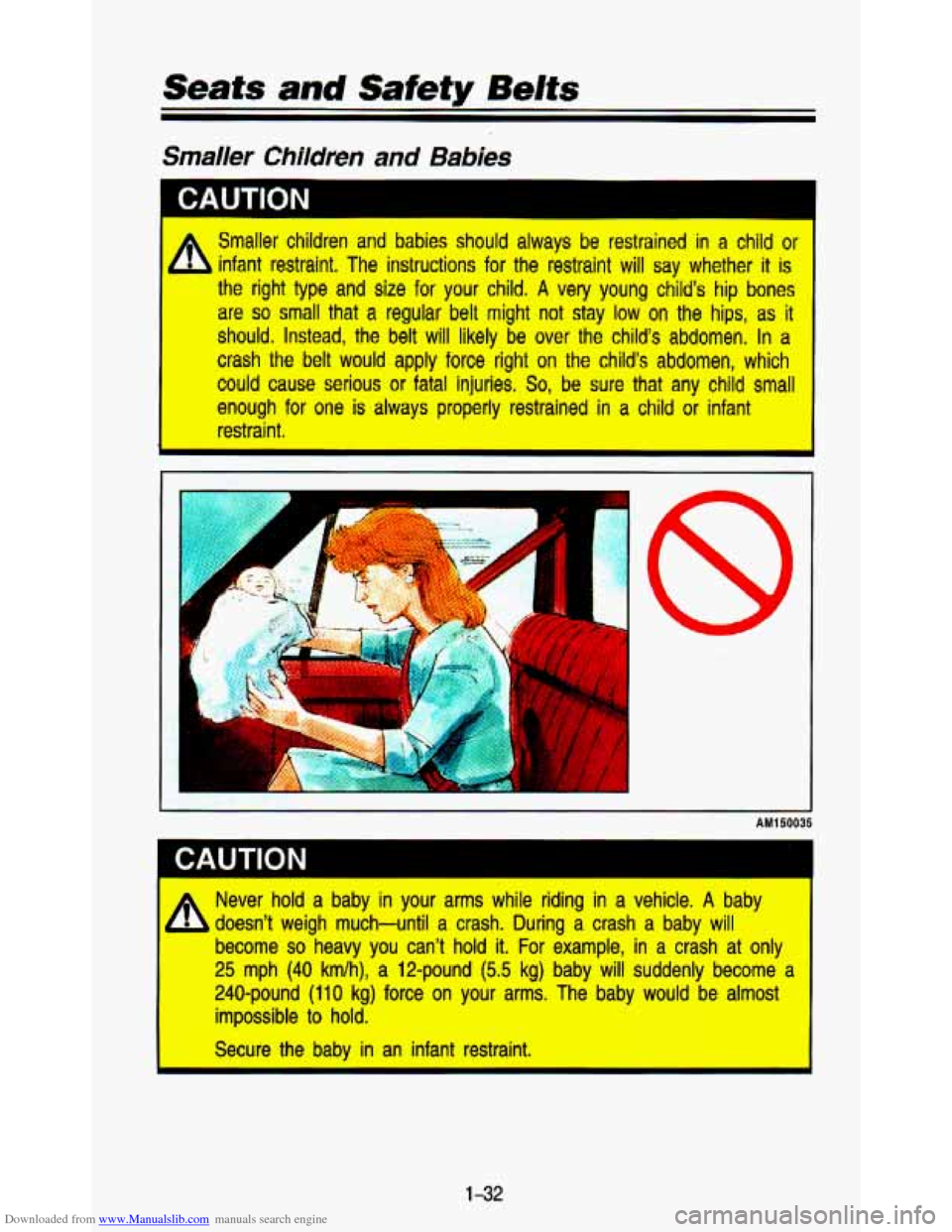
Downloaded from www.Manualslib.com manuals search engine Seats and Safety Belts
Smaller Children and Babies
I
Smaller children and babies should always be restrained in a child ot
infant restraint. The instructions for the restraint will say w\
hether it is
the right type and size for your child. A very young child's hip bones
are
so small that a regular belt might not stay low on the hips, as it
should. Instead, the belt will likely be over the child's abdo\
men.
In a
crash the belt would
apply force right on the child's abdomen, which
could cause serious or fatal injuries. So, be sure that any child small
enough for one is always properly restrained in a child or infant
restraint.
I
I-
I
A Never hold a baby in your arms while riding in a vehicle. A baby
doesn't weigh much-until a crash. During a crash a baby will become
so heavy you can't hold it. For example, in a crash at only
25 mph
(40 km/h), a 12-pound (5.5 kg) baby will suddenly become a
240-pound
(11 0 kg) force on your arms. The baby would be almost
impossible to hold.
Secure the baby in an infant restraint. ~ -. . . z .. A& 7,- . __ . . *.I
._ < ~ . . .. .- , -. . L I . ..
1-32